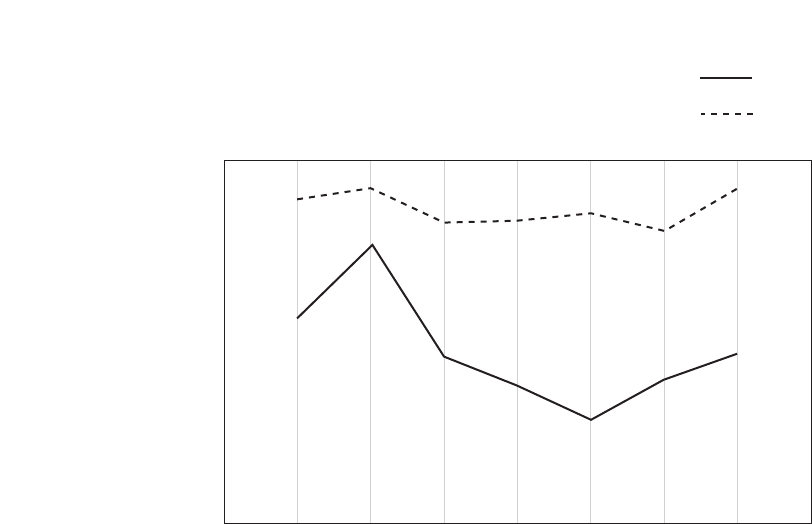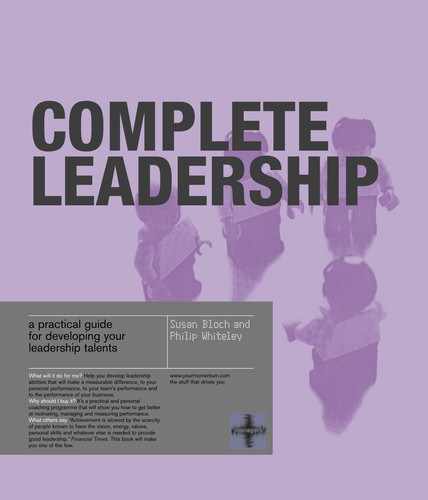
momentum complete leadership chapter five
97
pages 96 /
100
90
80
70
60
50
40
30
20
10
0
100
90
80
70
60
50
40
30
20
10
0
7.1
Coercive Authoritative Affiliative Democratic Pace-setting Coaching
70.2
8.7
72.4
93.7
80.5
Percentiles
66 = Dominant
50–65 = Backup
Managerial style inventory (Participant version)
Source:
Hay Group, 2002

100
90
80
70
60
50
40
30
20
10
0
100
90
80
70
60
50
40
30
20
10
0
18.5
Coercive Authoritative Affiliative Democratic Pace-setting Coaching
19
9.3
41.3
90.3
10.7
Percentiles
66 = Dominant
50–65 = Backup
Managerial style inventory (Employee version (N = 7))
Source:
Hay Group, 2002

momentum complete leadership chapter five
99
pages 98 /
100
90
80
70
60
50
40
30
20
10
0
100
90
80
70
60
50
40
30
20
10
0
Flexibility
Responsibility
Standards
Rewards
Clarity
Team commitment
Total
69.6
58.5
89.3
84.1
96.2
93.4
82.2
69.7
85.5
77
66.4
48.9
90.1
80.5
Percentiles
Actual
Ideal
Organizational climate survey (Participant version)
Source:
Hay Group, 2002

What Bob did was to develop a better dialogue with himself. He
acknowledged his internal voices – the commonest of which we
discussed in Chapter 2 – which are often so familiar to us that we
don’t recognize how loaded or even extreme they may be. Internal
dialogue is something that everyone engages in, but people who are
more self-aware have developed a more conscious process. They
know what they are saying to themselves and they can improve and
correct the messages. There has been recent research on brain activity
patterns indicating a strong correlation between inner speech and
self-awareness. One researcher, Dr Alain Morin of Quebec
University, concludes:
100
90
80
70
60
50
40
30
20
10
0
100
90
80
70
60
50
40
30
20
10
0
Flexibility
Responsibility
Standards
Rewards
Clarity
Team commitment
Total
89.3
56.7
92.4
77.1
82.5
46
83
38.1
85.3
18.7
80.6
39.7
92.6
47.3
Percentiles
Actual
Ideal
Organizational climate survey (Employee version (N = 7))
Source:
Hay Group, 2002

‘I suggest that the brain regions involved in self-awareness are
identical to the regions responsible for inner speech. This can
be taken as additional evidence of a link between self-talk and
self-focus.’
Crucially, for the purposes of our discussion here, one of the many
psychological studies that Dr Morin cites involved participants
engaged in comparing themselves against adjectives describing
certain human traits – very similar to the questionnaires that create
the management style charts we show in this chapter.
21
Strong differences between how we think we are and how others see
us can have at their root damaging internal voices, as discussed in
Chapter 2. Hence the importance of recognizing the links between
the way in which we see ourselves and the way in which we talk
with ourselves.
Some leaders are naturally reluctant to spend too long ‘navel gazing’.
Indeed, at its extreme, too much absorption in how we come across
can result in excessive self-consciousness, feeding doubt, indecision
and too much distraction from the outside world. But note the stress
here on the word ‘positive’ as well as the word ‘dialogue’. The
purpose of this exercise is to improve organizational performance,
not simply engage in the fun process of learning about ourselves. It’s
a question of being aware of our strengths and weaknesses, telling
ourselves about the strengths and building on them, making the
links between these, the reaction of our teams, how they perform and
hence how the business performs. As we said in Chapter 2 we learn
more from what we do well than we do from our mistakes, but it’s
difficult to learn from either if we don’t know what they are.
momentum complete leadership chapter five
101
pages 100 /
Internal dialogue is something that everyone engages
in, but people who are more self-aware have
developed a more conscious process.
..................Content has been hidden....................
You can't read the all page of ebook, please click here login for view all page.
